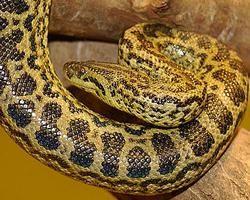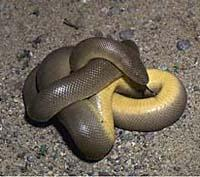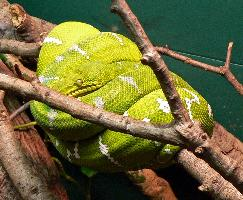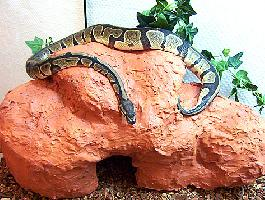
Váhy a míry
| Délka | 3,5 m |
|---|
Stav ohrožení
| Neohrožen |
Popis zvířete
The Yellow Anaconda (Eunectes notaeus) is a fascinating and formidable reptile species belonging to the boa family. Native to South America, it thrives in aquatic environments, making its home in swamps, marshes, and slow-moving rivers across countries such as Bolivia, Paraguay, Brazil, and Argentina. This species is one of the four recognized species of anacondas and is known for its striking coloration and impressive size, though it is smaller than its more famous relative, the Green Anaconda (Eunectes murinus).Characterized by a robust and muscular body, the Yellow Anaconda can reach lengths of up to 4.6 meters (15 feet), with females generally outgrowing males. Its skin is a beautiful canvas of yellow or golden-brown, adorned with black or dark brown blotches, bands, and rosette patterns that provide excellent camouflage in the dappled sunlight of its watery habitats. This coloration not only helps it to blend into the murky waters and dense vegetation but also plays a crucial role in its hunting strategy.
As a semi-aquatic creature, the Yellow Anaconda spends a significant amount of time in water. Its eyes and nostrils are positioned on top of its head, allowing it to submerge almost entirely while keeping a lookout for prey and breathing. This adaptation, along with its powerful body, makes it an adept swimmer and a stealthy predator.
The diet of the Yellow Anaconda is diverse, consisting of a wide range of prey including fish, birds, rodents, and even larger mammals such as capybaras. They are constrictors, meaning they do not possess venom but kill their prey by coiling around it and squeezing until suffocation occurs. This method of hunting highlights their incredible strength and patience as they wait for the perfect moment to strike from the water or from the cover of vegetation.
Reproduction in Yellow Anacondas is as intriguing as their hunting methods. They are ovoviviparous, meaning the females give birth to live young. Mating involves a breeding ball, where multiple males may wrap around a single female in water, competing for the chance to mate. After a gestation period, the female gives birth to anywhere between 20 to 60 young anacondas, which are independent from birth and receive no parental care.
Despite their size and predatory nature, Yellow Anacondas face threats from habitat loss and human activities. They are sometimes hunted for their skin or killed out of fear, though their exact conservation status is not well-documented. Efforts to understand and protect these remarkable reptiles are crucial for their continued survival in the wild.
In summary, the Yellow Anaconda is a captivating species with a unique set of adaptations that make it a master of its aquatic and semi-aquatic environments. Its role as a top predator in these ecosystems underscores the importance of conserving its natural habitats to ensure the balance of these complex food webs is maintained.
Podobná zvířata
Nové fotografie zvířat
Top 10 zvířat
- Chinese water dragon (Physignathus cocincinus)
- Galápagos tortoise (Geochelone nigra complex)
- Dolphin gull (Leucophaeus scoresbii)
- Japanese macaque (Macaca fuscata)
- Colombian red howler (Alouatta seniculus)
- Sea urchins (Echinoidea)
- Moustached guenon (Cercopithecus cephus)
- Diana monkey (Cercopithecus diana)
- Common reed warbler (Acrocephalus scirpaceus)
- Common house mosquito (Culex pipiens)


